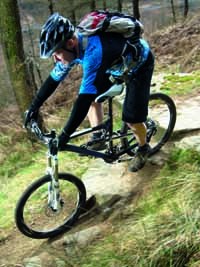 Frame
Frame
Integration is the name of the game on the Zesty frame. It sports an integrated headset where the cartridge bearing rests directly on the inner surface of the head tube. The theme is then repeated on the extra-wide bottom bracket shell, where the Shimano HollowTech II bottom bracket bearings are pressed in, eliminating the need for conventional bearing cups. ISCG tabs come as standard so you can easily fit a chain device, and it’s a good indication of the bike’s ‘all mountain’ credentials. Finally, the front mech bolts directly to the main pivot. Headset bearing quality isn’t great and ours exploded after a couple of rides. Once replaced with Cane Creek bearings we had no further problems.
Suspension
The OST suspension on the Zesty is something of a hybrid design. It uses a Horst link chainstay pivot (found on Specialized full-suspension bikes) and the counter-rotating upper link, which falls within Santa Cruz’s intellectual property. A sag indicator on the seatstays takes the guesswork out of set-up, and indicates a usable window between XC and AM. Because the Lapierre’s instant centre or virtual pivot point migrates as the suspension compresses, changing the sag has a noticeable difference on pedalling efficiency. Basically, moving the pivot has the same effect as changing the chainring size. Overall we experienced no noticeable pedal feedback, even in the granny ring, and the OST design gives great bump absorption.
Wheels
Manufacturers have been supplying bikes with tubeless wheels for years and finally we get a bike that actually has tubeless tyres to go with them. The Michelins are fast rolling and good quality, but they are definitely more of a summer tread than an all-rounder. Shimano XT wheels are excellent: strong, stiff and the rims are wide enough for higher volume tyres.
Groupset
Formula Oro brakes have stacks of power but you have to run the brakes and shifter well inboard of the grip to get the most out of them. As a result, riders with smaller hands will struggle to reach the shifter paddles. Formula needs to produce integrated shifter claps that are compatible with Shimano shifters like the Sram ones fitted to the Cube.
Performance
Even though all of the test bikes were fitted with the same Maxxis control tyres, the Lapierre didn’t have the same turn of speed as the Cannondale or Orange. On long traverses you have to stay on the gas to keep the Zesty up to speed as the suspension doesn’t give you much to push against if you want to pump for extra zip. However, once you get it rolling, the Lapierre is an amazingly stable bike. It squashes blind rises and feels very flat in the air, never pitching you forward or wanting to loop out. Weight distribution between the wheels is balanced and while its geometry is verging on extreme, it works. Also, the swingarm is very stiff for a lightweight linkage bike. The rear suspension definitely helps isolate the rider from square-edge hits but it also causes the bike to feel a bit wallowly through compression and while climbing. Running the bike in the XC sag position helps reduce this without robbing you of travel, and makes the bike feel more taught. The only drawback with the progressive geometry is that you have to set up early on switchbacks to guarantee that you make it round and we’d prefer a shorter stem to stop the steering flopping at low speed.
Verdict
With its slack head angle, long wheelbase and plush suspension, the Lapierre Zesty 514 is easily the most ‘all-mountain’ bike on test and feels similar to a Specialized Enduro SL. From the get-go it screams high-speed, rough terrain with a good measure of gravitational pull. However, that’s not to say it’s a mini DH rig, as the Zesty is light enough to be pedalled up the steepest ascents, even if it is not as swift as some of the others here. If you feel over-terrained or under-skilled, you’ll love the invincibility that the Zesty oozes. However, some riders found that the isolated feel of the Zesty robbed them of the sensation of speed on average UK trials.
MBR RATING: 9/10



